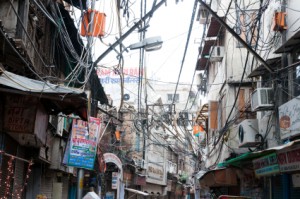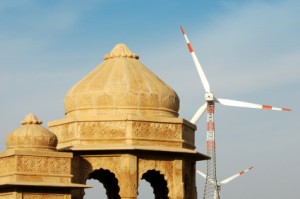On Tuesday, July 31st, the nation of India experienced the biggest power failure in the history of the world, as approximately 670 million people in the northern and eastern parts of the country lost their electrical service for several hours. This broke a record that had been established just one day earlier, when 370 million Indians living in the northern part of the country had been left without power for a similar period of time. Overall, twenty out of the nation’s twenty-nine states were affected by this electrical outage, which paralyzed hospitals and airports, left thousands of passengers riding one of the world’s largest rail systems stranded on the tracks, caused massive traffic jams in several cities by knocking out their traffic lights, and left hundreds of miners trapped underground.
 Indian authorities blamed both failures on two sources: greedy state electrical boards whose demands for power exceeded their allotments and dispatchers at state and local levels who refused to throw the circuit breakers that would have cut off supplies to the states that were taking more electricity than they were entitled to. While this excuse was certainly convenient, it is also somewhat odd, because you would think the same mistakes would not be made on two consecutive days, especially given how massive the failure of July 30th had been. Others have been pointing the finger of blame at Indian farmers, who have been using electric pumps to bring groundwater up to the surface for irrigation to compensate for water shortages that have occurred because of a drier-than-usual monsoon season.
Indian authorities blamed both failures on two sources: greedy state electrical boards whose demands for power exceeded their allotments and dispatchers at state and local levels who refused to throw the circuit breakers that would have cut off supplies to the states that were taking more electricity than they were entitled to. While this excuse was certainly convenient, it is also somewhat odd, because you would think the same mistakes would not be made on two consecutive days, especially given how massive the failure of July 30th had been. Others have been pointing the finger of blame at Indian farmers, who have been using electric pumps to bring groundwater up to the surface for irrigation to compensate for water shortages that have occurred because of a drier-than-usual monsoon season.
Certain structural realities in the Indian energy sector have contributed to the strain the country’s power grid has been undergoing in recent months. For example, the government has been encouraging the overuse of electricity by mandating that it be sold at prices that are lower than the cost of production. Also, many farmers are actually being given their power for free, which leaves them with little incentive to save or conserve. Eschewing privatization, the government has continued to maintain control over the operation of the coal industry in India, which as a result, is being run very inefficiently and is having an extremely difficult time keeping up with rising demand from the country’s power plants. The government has repeatedly stated that it plans to construct more coal and gas-burning plants in the near future, but just exactly how they expect to be able to pay for it – or for upgrades to the existing grid – is far from clear.
Currently, the Indian grid is running a 12 percent deficit in electricity generation during times of peak demand, and the result is that even before this blackout the Indian people had gotten used to intermittent power service. In smaller cities and towns, it is not unusual for electricity to be cut off for up to half a day, and even in the larger metropolitan areas periodic shutdowns have become a way of life. But the situation is even worse in rural areas and the very smallest villages, where most do not have any access to the grid at all. In total, there are 300 million Indians, or 25 percent of the population, who have to survive without electrical service.
Making The Choice: The “Tragedy Of The Stupid” Or Energy Self-Sufficiency?
The conventional explanations for the Indian power failure are all legitimate concerns, and they help to explain the calamitous events of July 30-31 to some extent. But there is something more fundamental at work here than just mistakes in policy making. More than anything else, what happened in India seems to be a classic example of the tragedy of the commons [1], where people become so dependent on a limited resource for their livelihood and survival that they feel like they have no choice but to use it indiscriminately and irresponsibly, even though they know the results could potentially be disastrous for everyone in the future. In recent years, India has been experiencing a significant expansion in its rate of economic growth, and it now possesses the third largest economy in all of Asia.
But that growth has been achieved primarily by following the standard model, which means that it has been driven in large part by a reliance on cheap electricity generated by primitive fossil fuel combustion, supplied to the country’s producers and consumers by the country’s antiquated power grid system. This situation is backing political decision makers at the state and local levels into a corner, where they feel they have no choice but to keep asking for more and more electricity even though everyone realizes the system has not been set up to handle these increasing demands. And even though subsidizing the costs of electricity adds inefficiencies into the marketplace, if this is the only way that people and businesses can afford to purchase a product that has become so vitally important to the nation’s economic functioning, then again India’s political leaders probably feel as if they have no choice but to follow this path.
Amazing “Solar Generator” Is Like Having A Secret Power Plant Hidden In Your Home! [2]
 There is a surprising postscript to the Indian power failure story, however: despite all the rhetoric about the inadequacies of the Indian power generation system and the desperate need to upgrade the grid in order to prevent India from slipping back into the Stone Age, renewable energies are actually beginning to make a huge impact in this nation. India’s wind and solar energy economies are among the fastest growing in the world, and while some of the new investments are going to large-scale projects designed to feed power into the grid, small-scale alternative energy industry is also benefiting from the country’s push into renewables, and off-the-grid solar energy systems are starting to proliferate in rural areas, especially where the grid is not available. Rural residents who have been installing photovoltaic panels and purchasing different forms of solar lighting have been effusive in their praise for the technology, and while there are some cost barriers, non-profit organizations and solar energy providers have come up with some clever schemes to help relatively poor Indians pay for renewable systems incrementally over time.
There is a surprising postscript to the Indian power failure story, however: despite all the rhetoric about the inadequacies of the Indian power generation system and the desperate need to upgrade the grid in order to prevent India from slipping back into the Stone Age, renewable energies are actually beginning to make a huge impact in this nation. India’s wind and solar energy economies are among the fastest growing in the world, and while some of the new investments are going to large-scale projects designed to feed power into the grid, small-scale alternative energy industry is also benefiting from the country’s push into renewables, and off-the-grid solar energy systems are starting to proliferate in rural areas, especially where the grid is not available. Rural residents who have been installing photovoltaic panels and purchasing different forms of solar lighting have been effusive in their praise for the technology, and while there are some cost barriers, non-profit organizations and solar energy providers have come up with some clever schemes to help relatively poor Indians pay for renewable systems incrementally over time.
Keep Telling Yourself, “It Can’t Happen Here”
It may be an exaggeration to say that all electric power grids are doomed, but it is clear that grids as they are currently managed and operated are unsustainable and basically a disaster waiting to happen. Power grids are incredibly costly to build, maintain, and replace, and over time, the growth in power demands from private consumers inevitably stretch them to the breaking point.
Here in the United States, new investments in grid-based energy production have not been keeping up with the costs of amortization and depreciation since 1995 [3], and given the budget crises that governments are facing at every level, this situation is not likely to change any time soon. Power failures of various types are already costing the U.S. economy between $88 billion and $188 billion annually, and the problem will only get worse in the coming years as our outdated grid continues to decay.
But of course there is another way. Off-the-gridders are the new pioneers in American life, and they are helping to provide a blueprint for energy self-sufficiency and independence that can help guide the way to a better future. Rural Indians are only now beginning to explore the concept of energy self-sufficiency, and if knowledge of and support for small-scale renewable energy begins to increase in that nation, it could do more to solve their energy problems than expensive, pie-in-the-sky new construction schemes designed to protect India’s overtaxed grid from its inevitable implosion.
Even many who support home energy systems and the cause of energy self-sufficiency accept the assertion that a well-maintained and properly functioning grid must be a part of the solution to our collective power generation problem. But whether or not this is true, there is no question that the current societal model that relies on overly centralized large-scale energy generation to fuel all economic growth is not sustainable in the long run. All of the empty rhetoric about “smart grids” [4] aside, mega-grids that are designed to somehow by some miracle meet all the power needs of a nation are ultimately doomed to failure, and the best way to protect yourself from such a catastrophe is to pursue your energy independence – and your personal independence – now by getting off the grid while there is still time.
What happened in India is both a warning and a wake-up call. If you have been considering making the move off the grid but have not yet done so, you should take these recent events as a sign that the time has finally come to take that huge penultimate step on your road to personal freedom and independence.
©2012 Off the Grid News
